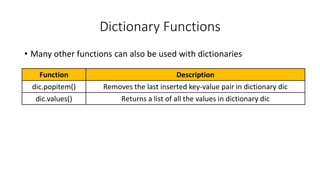This document discusses tuples and dictionaries in Python. Tuples are immutable sequences that are defined using parentheses, while dictionaries are mutable mappings that associate keys with values. The document provides examples of creating, accessing, iterating over, and modifying tuples and dictionaries using various built-in functions and methods. It also compares the differences between tuples, lists, and dictionaries.
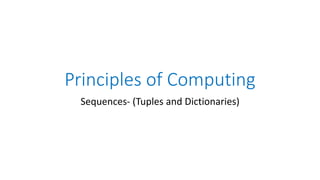
![Tuples
• Tuples are very similar to lists, but they are immutable (i.e.,
unchangeable)
• Tuples are written with round brackets as follows:
t1 = (1, 2, 3)
t2 = (“a”, “b”, “c”, ”d”)
t3 = (200, “A”, [4, 5], 3.2)
print(t1)
print(t2)
print(t3)](https://image.slidesharecdn.com/tuples-and-dictionaries-230519163816-277fbe5b/85/Tuples-and-Dictionaries-pptx-2-320.jpg)
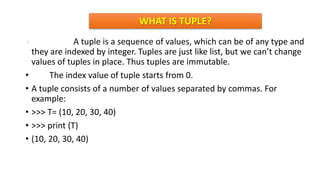
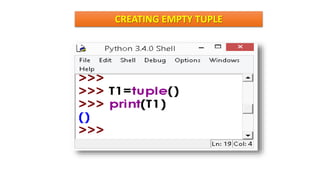
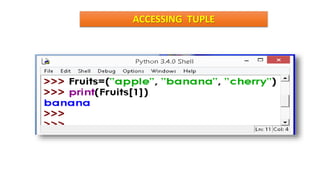
![Tuples
• Like lists, tuples can:
• Contain any and different types of elements
• Contain duplicate elements (e.g., (1, 1, 2))
• Be indexed exactly in the same way (i.e., using the [] brackets)
• Be sliced exactly in the same way (i.e., using the [::] notation)
• Be concatenated (e.g., t = (1, 2, 3) + (“a”, “b”, “c”))
• Be repeated (e.g., t = (“a”, “b”) * 10)
• Be nested (e.g., t = ((1, 2), (3, 4), ((“a”, “b”, ”c”), 3.4))
• Be passed to a function, but will result in pass-by-value and not pass-by-
reference outcome since it is immutable
• Be iterated over](https://image.slidesharecdn.com/tuples-and-dictionaries-230519163816-277fbe5b/85/Tuples-and-Dictionaries-pptx-6-320.jpg)
![Examples
t1 = ("a", "b", "c")
print(t1[::-1])
t2 = ("a", "b", "c")
t3 = t1 + t2
print(t3)
t3 = t3 * 4
print(t3)
for i in t3:
print(i, end = " ")
print()
This will print the elements of t1 in
a reversed order, but will not change
t1 itself since it is immutable
This will concatenate t1 and t2 and
assign the result to t3 (again, t1 and
t2 will be unchanged since they are
immutable)
This will repeat t3 four times and
assign the result to t3. Hence,
t3 will be overwritten (i.e., NOT
changed in place- because it is
immutable-, but redefined with a
new value)](https://image.slidesharecdn.com/tuples-and-dictionaries-230519163816-277fbe5b/85/Tuples-and-Dictionaries-pptx-7-320.jpg)
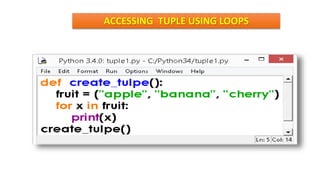


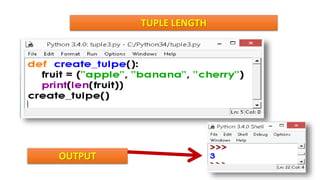

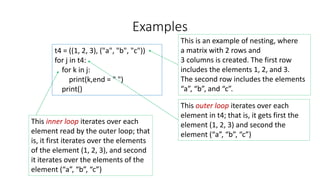

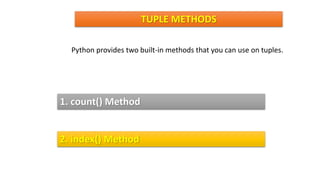

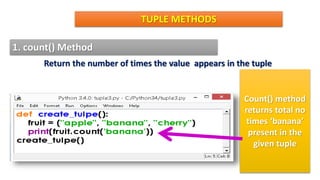

![DIFFERENCE BETWEEN LIST AND TUPLE
LIST TUPLE
Syntax for list is slightly different
comparing with tuple
Syntax for tuple is slightly different
comparing with lists
Weekdays=[‘Sun’,’Mon’,
‘wed’,46,67]
type(Weekdays)
class<‘lists’>
twdays =(‘Sun’, ‘mon', ‘tue', 634)
type(twdays)
class<‘tuple’>
List uses [ and ] (square brackets)
to bind the elements.
Tuple uses rounded brackets( and ) to
bind the elements.](https://image.slidesharecdn.com/tuples-and-dictionaries-230519163816-277fbe5b/85/Tuples-and-Dictionaries-pptx-19-320.jpg)

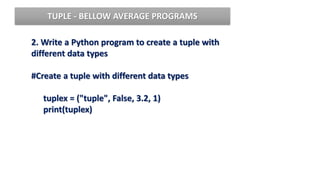
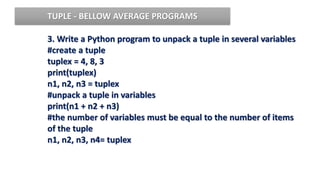



![5. Write a Python program to add an item in a tuple.
#adding items in a specific index
tuplex = tuplex[:5] + (15, 20, 25) + tuplex[:5]
print(tuplex)
#converting the tuple to list
listx = list(tuplex)
#use different ways to add items in list
listx.append(30)
tuplex = tuple(listx)
print(tuplex)
TUPLE - AVERAGE PROGRAMS](https://image.slidesharecdn.com/tuples-and-dictionaries-230519163816-277fbe5b/85/Tuples-and-Dictionaries-pptx-26-320.jpg)


![Dictionaries
• In summary, dictionaries:
• Can contain any and different types of elements (i.e., keys and values)
• Can contain only unique keys but duplicate values
• Can be indexed but only through keys (i.e., dic2[“a”] will return 2 but dic2[0]
will return an error since there is no element with key 0 in dic2 above)
Output: {'a': 2, 'b': 2}
dic2 = {"a":1, "a":2, "b":2}
print(dic2)
The element “a”:2 will override the element “a”:1
because only ONE element can have key “a”](https://image.slidesharecdn.com/tuples-and-dictionaries-230519163816-277fbe5b/85/Tuples-and-Dictionaries-pptx-29-320.jpg)
![Dictionaries
• In summary, dictionaries:
• CANNOT be concatenated
• CANNOT be repeated
• Can be nested (e.g., d = {"first":{1:1}, "second":{2:"a"}}
• Can be passed to a function and will result in a pass-by-reference and not
pass-by-value behavior since it is immutable (like lists)
Output:
{'first': {1: 1}, 'second': {2: 'a'}}
{'first': [1, 2, 3], 'second': {2: 'a'}}
def func1(d):
d["first"] = [1, 2, 3]
dic = {"first":{1:1},
"second":{2:"a"}}
print(dic)
func1(dic)
print(dic)](https://image.slidesharecdn.com/tuples-and-dictionaries-230519163816-277fbe5b/85/Tuples-and-Dictionaries-pptx-30-320.jpg)

![Dictionaries
• In summary, dictionaries:
• Can be iterated over
Output:
dic = {"first": 1, "second": 2, "third": 3}
for i in dic:
print(dic[i])
1
2
3
Values can be accessed via indexing!](https://image.slidesharecdn.com/tuples-and-dictionaries-230519163816-277fbe5b/85/Tuples-and-Dictionaries-pptx-32-320.jpg)
![Adding Elements to a Dictionary
• How to add elements to a dictionary?
• By indexing the dictionary via a key and assigning a corresponding value
Output:
dic = {"first": 1, "second": 2, "third": 3}
print(dic)
dic["fourth"] = 4
print(dic)
{'first': 1, 'second': 2, 'third': 3}
{'first': 1, 'second': 2, 'third': 3, 'fourth': 4}](https://image.slidesharecdn.com/tuples-and-dictionaries-230519163816-277fbe5b/85/Tuples-and-Dictionaries-pptx-33-320.jpg)
![Adding Elements to a Dictionary
• How to add elements to a dictionary?
• By indexing the dictionary via a key and assigning a corresponding value
Output:
dic = {"first": 1, "second": 2, "third": 3}
print(dic)
dic[”second"] = 4
print(dic)
{'first': 1, 'second': 2, 'third': 3}
{'first': 1, 'second’: 4, 'third': 3}
If the key already exists,
the value will be overridden](https://image.slidesharecdn.com/tuples-and-dictionaries-230519163816-277fbe5b/85/Tuples-and-Dictionaries-pptx-34-320.jpg)
![Deleting Elements to a Dictionary
• How to delete elements in a dictionary?
• By using del
Output:
dic = {"first": 1, "second": 2, "third": 3}
print(dic)
dic["fourth"] = 4
print(dic)
del dic["first"]
print(dic)
{'first': 1, 'second': 2, 'third': 3}
{'first': 1, 'second': 2, 'third': 3, 'fourth': 4}
{'second': 2, 'third': 3, 'fourth': 4}](https://image.slidesharecdn.com/tuples-and-dictionaries-230519163816-277fbe5b/85/Tuples-and-Dictionaries-pptx-35-320.jpg)
![Deleting Elements to a Dictionary
• How to delete elements in a dictionary?
• Or by using the function pop(key)
Output:
dic = {"first": 1, "second": 2, "third": 3}
print(dic)
dic["fourth"] = 4
print(dic)
dic.pop(“first”)
print(dic)
{'first': 1, 'second': 2, 'third': 3}
{'first': 1, 'second': 2, 'third': 3, 'fourth': 4}
{'second': 2, 'third': 3, 'fourth': 4}](https://image.slidesharecdn.com/tuples-and-dictionaries-230519163816-277fbe5b/85/Tuples-and-Dictionaries-pptx-36-320.jpg)

